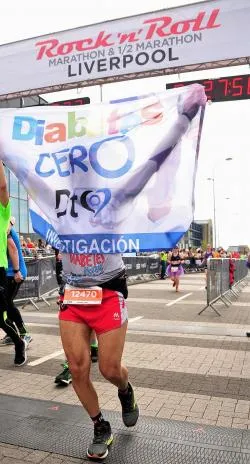Indeed, cardiac work maintained in 60-70% of the FCMAX, mostly mobilizes the reserve of body fats as the main fuel, as long as that exercise extends for at least one hour.
In an aerobic exercise maintained (whatever the intensity), the muscular ATP reserves are first consumed, then the Current HCs in the blood are burned, then the glycogen reserves accumulated in the liver are available thanks to the glucagonAnd finally, if the exercise continues over time and becomes longer, neo -Glucogenesis is produced, process through which fat burns to "manufacture" HC.This occurs if the exercise has a certain intensity (low in intensity, long over time).If the intensity is higher, the body will need faster HC.
For a diabetic, any exercise is possible, provided you have no problems of some kind;especially vascular.But the most recommended is that of a sustainable and maintained aerobic process;especially that of low and half intensity, where the metabolism of sugars is not too altered.If we perform anaerobic activity (maximum intensity exercise), there is much more important than our metabolic system, which does not happen to us in diabetics, so that the possibilities that glycemia are very altered.
The most recommended exercise is, therefore, the one that maintains a frequency around 60-70% (fat burning) or 70-80% (aerobic work).While the first is bearable by almost any person, the second is more intense and is only achieved comfortably after daily and maintained training.As for the burning of fats that it produces, it has traditionally been said that for that it was needed to be in the 60-70%area, but lately it is being seen that in reality you burn more fat (and more HC TB) in the aerobic zone(70-80%).The difference is that while the first is softer and glycemia are more controllable, in the second more factors and glycemias intervene during and after the effort they are more unpredictable (glucose is consumed up to 30 hours after the exercise, with the possibility ofhypo that entails).
I have tried all areas a lot.And I have been abandoning the highest (anaerobic) areas for being too violent and demanding great over -relief without such an evident benefit as the others.If you run to run and see that your pulsations shoot overcoming your work area (which you should set in the pulsometer to let you know), you must stop running and keep walking.If you see that then your pulsations lower below the lower limit, run again.What you should do is stay in the area.Keeping in pulsations as high as you manifest (check if that is for you anaerobic zone), it will only produce fatigue in a short time and a void benefit.The advantage of a pulsometer is to be able to control our engine.It is like the courses of a car.We look at him to see that we are not going from revolutions when putting the marches and not burning the engine.Well here the same.If we go from revolutions, the heart fatigue unnecessarily.The greatest benefits are achieved in intermediate areas (always speaking of training for someone normal, not an amateur or elite athlete).And the pulsometer allows you to monitor those areas.
Finally, very important, if you do aerobic training (and especially if you are frequently exceeded, and go to anaerobic), it is essential that you make an effort test, an echo cardio and if you can, an echo of stress.Remember that we are people at risk.And the more you are, the more important you are making these checks every several years.
ISCI / debut: 1986 / HbA1c: 5,5%


